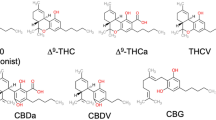Abstract
Cannabis has been around for thousands of years and has been used recreationally, medicinally, and for fiber. Over 500 compounds have been isolated from Cannabis sativa with approximately 105 being cannabinoids. Of those 105 compounds, Δ9-tetrahydrocannabinol has been determined as the primary constituent, which is also responsible for the psychoactivity associated with Cannabis. Cannabinoid receptors belong to the large superfamily of G protein-coupled receptors. Targeting the cannabinoid receptors has the potential to treat a variety of conditions such as pain, neurodegeneration, appetite, immune function, anxiety, cancer, and others. Developing in vitro bioassays to determine binding and functional activity of compounds has the ability to lead researchers to develop a safe and effective drug that may target the cannabinoid receptors. Using radioligand binding and functional bioassays, a structure–activity relationship for major and minor cannabinoids was developed.

Similar content being viewed by others
References
Ahmed S, Ross S, Slade D, Radwan M, Zulfiqar F, ElSohly M (2008) Cannabinoid ester constituents from high-potency Cannabis sativa. J Nat Prod 71:536–542
Benito C (2003) Cannabinoid CB2 receptors and fatty acid amide hydrolase are selectively overexpressed in neuritic plaque-associated glia in Alzheimer’s disease brains. J Neuro 23:136
Berry E, Mechoulam R (2002) Tetrahydrocannabinol and endocannabinoids in feeding and appetite. Pharm Ther 95:185–190
Cabral G, Griffin-Thomas L (2009) Emerging role of the cannabinoid receptor CB2 in immune regulation: therapeutic prospects for neuroinflammation. Expert Rev Mol Med 11:e3
Carlsson J (2010) Structure-based discovery of A adenosine receptor ligands. J Med Chem 53:3748–3755
Clarke R, Watson D (2010) Cannabis and Natural Cannabis Medicines. In: ElSohly MA (ed) Marijuana and the cannabinoids. Humana Press Inc, Totowa, pp 1–16
Devane W (1992) Isolation and structure of a brain constituent that binds to the cannabinoid receptor. Science 258:1946–1949
ElSohly MA (2000) Potency trends of delta-9-THC and other cannabinoids in confiscated marijuana from 1980–1997. J Foren Sci 45:24–30
Gaoni Y, Mechoulam R (1964) Isolation, structure, and partial synthesis of an active constituent of hashish. J Am Chem 86:1646–1647
Gerrard CM (1991) Molecular cloning of a human cannabinoid receptor, which is also expressed in testis. Biochem J 279:129
Harrigan M (2001) Cerebral salt wasting syndrome. Crit Care Clin 17:125–138
Hensen B (2005) Cannabinoid therapeutics: high hopes for the future. Drug Discov 10:459
Katoch-Rouse R (2003) Synthesis, structure activity relationship, and evaluation of SR141716 analogues: development of central cannabinoid receptor ligands with lower lipophilicity. J Med Chem 46:642–645
Lambert D (2009) Cannabis and endocannabinoids: the old man and the teenagers. In: Lambert DM (ed) Preface of cannabinoids in nature and medicine. Wiley-VCH, Weinheim
Matsuda LA (1991) Structure of a cannabinoid receptor and functional expression of the cloned cDNA. Nature 346:561–564
Mehmedic Z, Chandra S, Slade D, Denham H, Foster S, Patel A, Ross S, Kahn I, ElSohly M (2010) Potency trends of Δ9-THC and other cannabinoids in confiscated cannabis preparations from 1993 to 2008. J Forensic Sci 55:1209–1217
Munro S, Thomas K, Abu-Shaar M (1993) Molecular characterization of a peripheral receptor for cannabinoids. Nature 365:61–65
Onaivi E, Ishiguro H, Patel S, Perchuk A, Meozzi P, Myers L, Mora Z, Tagliaferro P, Gardner E, Brusco A, Akinshola B, Liu Q, Hope B, Iwasaki S, Arinami T, Teasenfitz L, Uhl G (2006) Discovery of the presence and functional expression of CB2 receptors in brain. Annals 1074:514–536
Pertwee R (1997) Pharmacology of cannabinoid CB1 and CB2 receptors. Pharmacol Ther 74:129–180
Pertwee R (1999) Pharmacology of cannabinoid receptor ligands. Curr Med Chem 6:635–664
Peters H, Nahas G (1999) A brief history of four millenia (B.C. 2000—A.D. 1974). In: Nahas GG (ed) Marihuana and Medicine. Humana Press Inc, Totowa, pp 3–7
Ross S, ElSohly M, Sultana G, Mehmedic Z, Hossain C, Chandra S (2005) Flavonoid glycosides and cannabinoids from the pollen of Cannabis sativa L. Phyto Anal 16:45–48
Xiong W, Cheng K, Cui T, Godlewski G, Rice K, Xu Y, Zhang L (2011) Cannabinoid potentiation of glycine receptors contributes to cannabis-induced analgesia. Nat Chem Biol 7:295–303
Acknowledgments
This study was supported by Grant Number P20GM104931 from the National Institute of General Medical Sciences (NIGMS), a component of the National Institutes of Health (NIH) and its contents are solely the responsibility of the authors and do not necessarily represent the official view of NIGMS or NIH. This investigation was conducted in a facility constructed with support from research facilities improvement program C06RR14503 from the NIH National Center for Research Resources.
Author information
Authors and Affiliations
Corresponding author
Rights and permissions
About this article
Cite this article
Husni, A.S., McCurdy, C.R., Radwan, M.M. et al. Evaluation of phytocannabinoids from high-potency Cannabis sativa using in vitro bioassays to determine structure–activity relationships for cannabinoid receptor 1 and cannabinoid receptor 2. Med Chem Res 23, 4295–4300 (2014). https://doi.org/10.1007/s00044-014-0972-6
Received:
Accepted:
Published:
Issue Date:
DOI: https://doi.org/10.1007/s00044-014-0972-6




